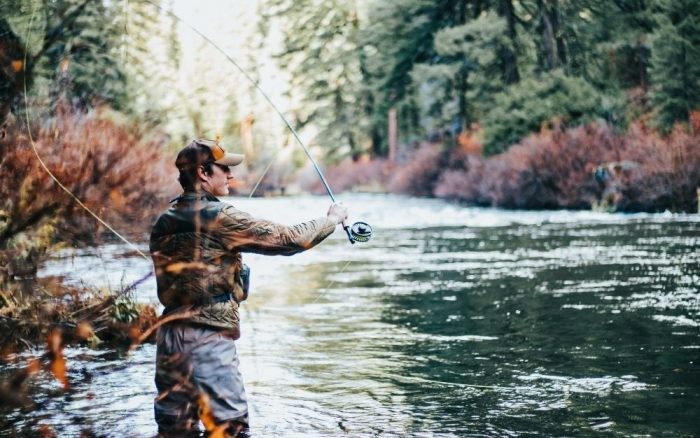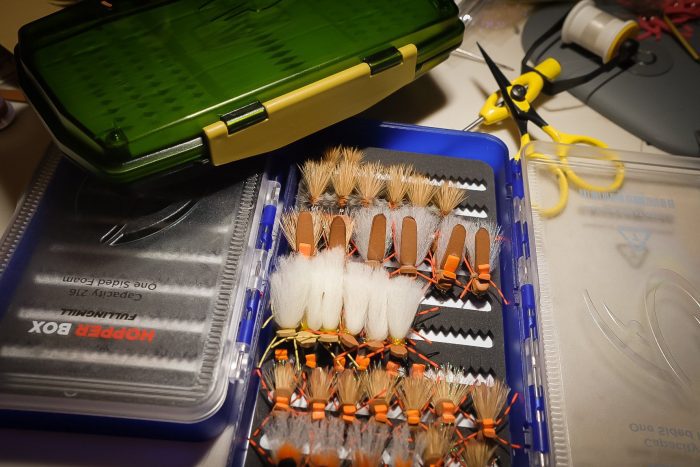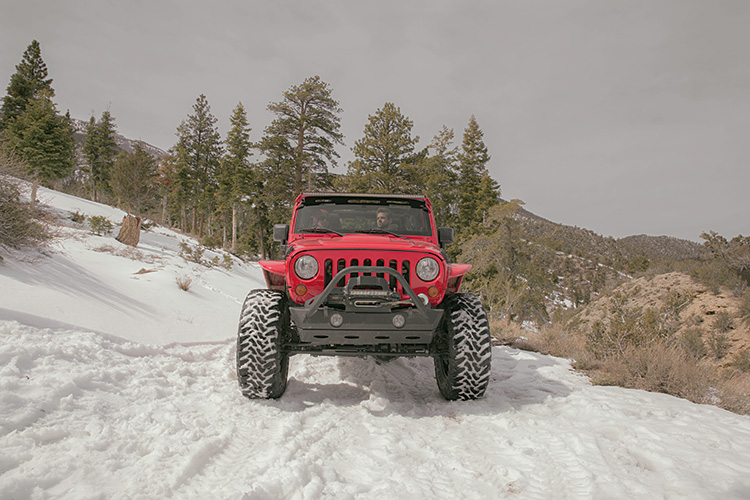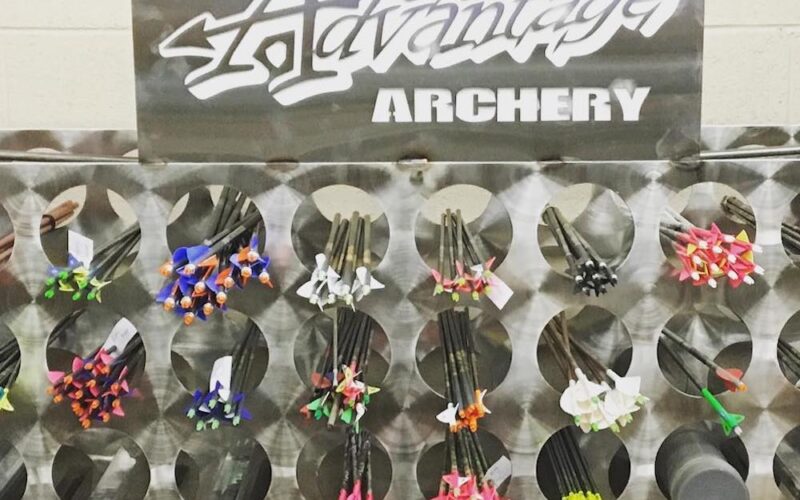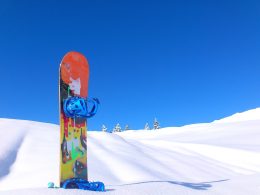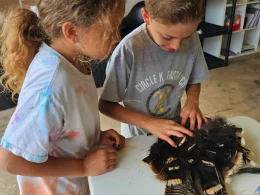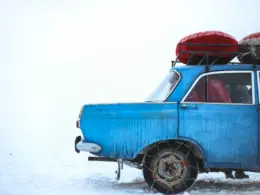It ain’t for the faint of heart. It’s cold, it’s wet and there’s a good chance it’s also windy. However, trout can still be caught and with the right techniques, flies, and proper clothing you can satisfy your fishing itch even in the middle of winter.
Table of Contents
Winter Fishing
Other than ice fishing you might not think about fishing as a winter pastime. After all, the thought of being in or on the water when it’s forty or colder isn’t very appealing. This is the beauty of trout though. They’re a coldwater fish that will still feed and be more active than some of their warmwater brethren, like bass.
If you’re new to fly fishing it’s a great way to learn how to nymph because the majority of the time that’s all you’ll be doing. Before it gets cold out you’ll want to load up on only a handful of flies, which again, is great if you’re a beginner. This way you’re not going to have to worry about matching the hatch or feel bogged down by having to choose which fly to use.
Fly Selection
I know, I know. Dry flies are awesome, but now is the time to set aside your adams and elk hair caddis for spring. Instead, bust out your light tippet, indicators, and split shot, because it’s nymphing season.
Zebra Midge
Midges continue their life cycle through the winter and make up the majority of a trout’s winter diet. This should be the first fly you tie on every time you head out to the river. Until proven otherwise assume that this is the premier fly to use in the cooler months.
You’ll want to use smaller sizes too. You should have multiple midges in your box that range in size from 18-22. You’ll also want to lighten your tippet, but we’ll talk about that further down.
In terms of color, you should have black, green, and red. You can tie all three of these onto one line if you’re not sure which color they prefer that day. Again, we’ll talk more about multi-rigs below.
Griffith’s Gnat
On warmer days around noon or later you may find that some midges are hatching. This is especially true on sprig-fed or tailwater rivers. That’s where the griffith’s gnat will be your best friend. If you start seeing trout rising in pools then you know that a hatch is occurring and you should take off that midge and tie on a gnat instead.
Hares Ear Nymph
One of the most natural stonefly nymph imitations. The hare’s ear is great for targeting trout all across the US. This is a great backup nymph to try if you feel like the midges just aren’t working that day. You’ll want to grab a few of these in sizes 12-18.
Wooly Bugger
Winter fishing can be a time to try and target trophy fish. Bigger trout don’t want to slurp thousands of midges every day so they’ll wait for something bigger to come along, like crawfish or baitfish.
The wooly bugger is a versatile fly that can imitate both of these. You can drop these off of an indicator, but I’ve had more success allowing them to sink in the water column and stripping them in slowly.
Black, white, and green are the colors I keep in my fly box. You can get them in sizes 6-12, but I usually stick with sizes 8-10.
Eggs
During the spawn, trout will go out of their way to lie behind nests and wait for eggs to fall out. The current will push it towards them and they’re rewarded with a protein-packed snack. Eggs are extremely versatile and are a great fly to tie on if you’re feeling overwhelmed by the flies listed above. Make sure this fly is hitting bottom and there’s no doubt you’ll pluck a few trout out of the river.
Multi Fly Rigs
They can be a little tricky to cast, but you can be rewarded with a day full of fish once you get the cast down. Lining up multiple flies on your line is a really fun way to figure out what the trout are keying in on.
Start with an indicator on your line. Below that tie on something flashy like a brightly colored nymph. Below that tie on a midge and below that tie on another midge of a different color. Use the shank of the hook to tie on a new tippet to create this trout buffet.
Feel free to try out all the different variations using the flies above. Dropping midges or eggs off of a wooly bugger can work very well, but you’ll need to be careful with casting since the weight of the wooly bugger can lead to tangles.
Having a multi-fly rig in the winter isn’t necessary, but it can drastically increase your chances of catching a fish and it can also help you narrow in on what the trout are eating that day.
Gear Needed
Clothing and accessories are going to be a different game in winter. The weather makes everything more difficult and you’ll need to be prepared to battle Mother Nature.
Clothing
This really depends on where you are in the country. So, you’ll need to make a judgment call the day of so you’ll know just how heavy or light you want to dress.
That being said, layers are your friend. A tight-fitting base is crucial to keeping warm. It doesn’t need to be anything crazy, but having something that easily fits underneath a pair of sweats can make the difference. After your base, I prefer to wear a lighter long-sleeved shirt. And on top of that either a jacket or a sweatshirt. These are easy to shed and tie around your neck or waist if the weather warms up as the day goes on.
As for pants I prefer to wear sweats. If it’s really cold I’ll wear them underneath a pair of jeans or any other type of long pants that has some stretch to them. Wool socks are needed as well. Only if you plan on doing a lot of wading though. Most, if not all waders have neoprene boots on them that are great for keeping out the cold.
Sock hats for the coldest of days, and I always have gloves. Sometimes I wear two different pairs. One is tighter and has the fingers cut out so that I can tie knots more easily, and the other is a pair of mittens that fold over at the top. Some hot hands can be great to keep in a pocket in your waders. These can be great if you need to tie a knot and your fingers are frozen.
Rod and Reel
The classic 9’ 5wt rod should be your go-to for the winter. This will allow you to throw nymphs and wooly buggers with ease. If you want to only nymph then you can downsize your rod to a 3wt or smaller if you’d like.
If you plan on targeting trophy trout with larger flies then you can upgrade to a 6wt or even a 7wt. If you’re trophy fishing then be prepared for long and slow days on the water. You may only catch a few fish, but they will typically be larger than average.
Your reel should also match the size of your rod. Don’t worry too much about getting an expensive reel or something with the best drag system out there. Just get something that will allow you to get out on the water.
Tippet
Keep it light during the winter. The water is normally low and clear so the trout are already spooky. The lighter the line the more realistic the fly will look in the water too. Ideally, you’ll be using a 5-6X tippet. This means the line will be around 3.5-5lb test. If you do wind hooking into a big fish you’ll have to keep in mind that you won’t have much strength to muscle in that fish.
If the water is off color either from a storm or is just naturally darker then you can get away with using a heavier line.
Prevent Frozen Line Guides
If you’re going to be fishing and it’s 32 or colder then you’ll need to be aware of the guides on your rod freezing over. I once watched someone lose a monster rainbow in the winter because his guides froze over and he couldn’t play the fish properly.
You can prevent this by spraying your guides with pam before leaving the house. This might not last your whole trip so keep some chapstick in your pocket. Apply this when you start to see your guides freezing over. Loon also makes a paste that can achieve the same goal and is proven safe for your fly line as well as the environment.
Safety
With the cold weather, you need to be even more careful when out on the water. If you don’t have the proper attire then fish from the bank. If you see ice on moving water then avoid it, no matter how safe it looks. Bringing a buddy is one of the best things you can do and can also just make the day more enjoyable. Also, be aware of the sun. It sets much quicker in winter and being caught in the woods during winter is not a fun walk.
Conclusion
Chasing trout in the winter can be the most difficult fishing of the year. Finicky trout and cold weather can make it challenging;][, but if you can catch trout when it’s cold then you can catch trout at any time. Also, there’s a good chance you’ll have the river all to yourself during this time of the year.
So, be safe, fish slow, and dress warm.

